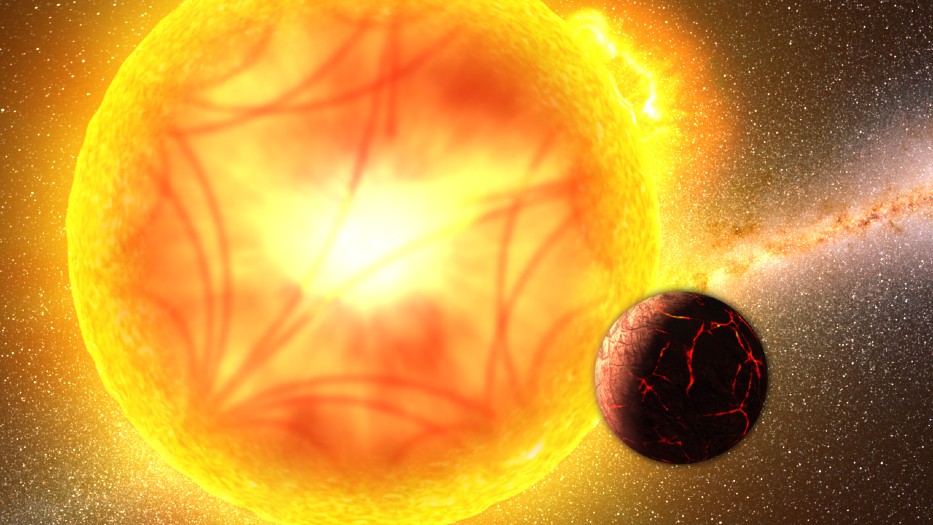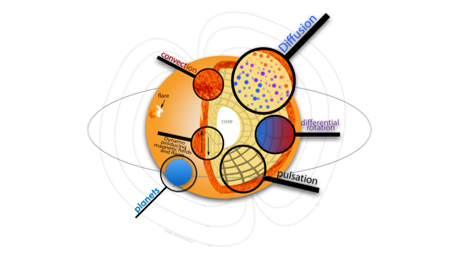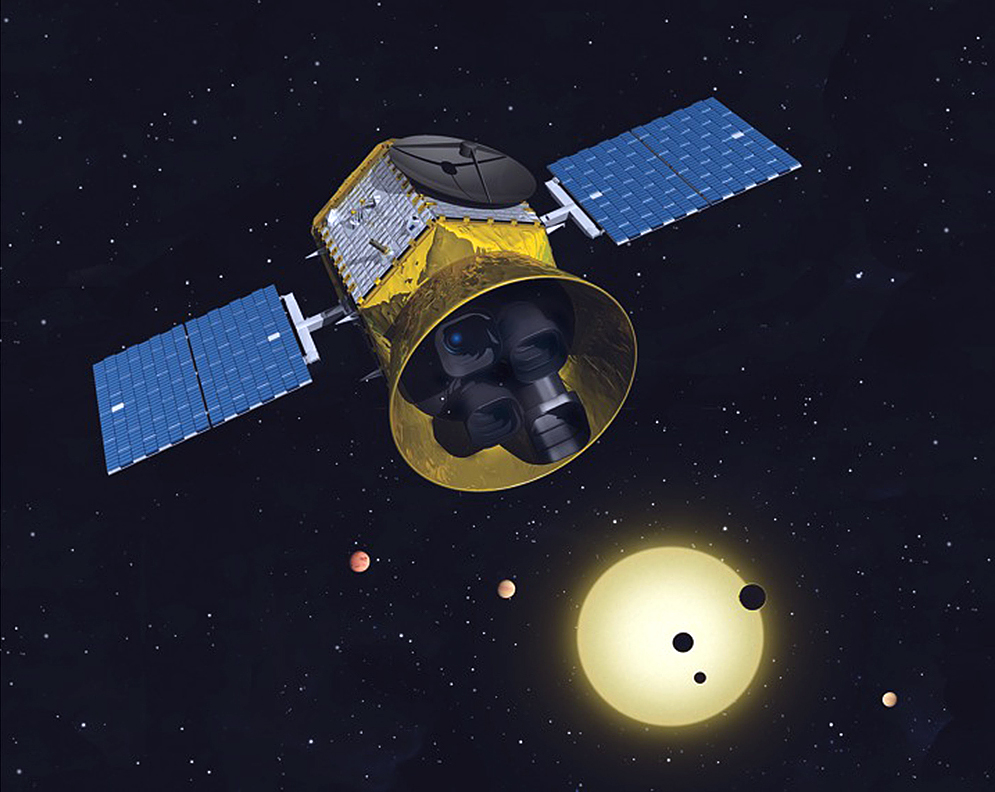Stellar Astrophysics Group
In this group we focus on astrophysical processes in intermediate-mass stars, which display complex variability originating either from pulsations, stellar spots, activity and/or companions.

Research group
Victoria Laura Antoci Senior researcher Phone: +45 45259691 vlaan@dtu.dk
Our research group delves into the complex variabilities exhibited by stars, particularly those with orbiting planets. These variabilities arise from a range of astrophysical processes including stellar pulsations, the presence of stellar spots, intrinsic stellar activity, and interactions with stellar companions. Our work aims to dissect the contributions of magnetic fields, diffusion, convection, and rotation to these variabilities, as these processes critically influence stellar structure and the evolutionary trajectory of both the stars themselves and their accompanying planetary systems.
Utilising the technique of asteroseismology, we probe the internal dynamics of stars, gaining insights into their internal structures. Our analyses are underpinned by data sourced from cutting-edge satellite missions, including Kepler, TESS, and Gaia. Additionally, we incorporate observations from ground-based observatories such as the Nordic Optical Telescope, ESO, and SONG to enrich our understanding of these celestial phenomena.
Through our research, we strive to enhance the understanding of the fundamental mechanisms that govern stellar behaviour and their implications for the broader astrophysical context of planetary system evolution.


The Quest for MAGNetIc Fields in A and F TYpe Stars
- MAGNIFY -
The ERC consolidator project, MAGNIFY, aims to decipher the mysteries surrounding magnetic fields in stars, especially those beyond the 1.3 solar mass threshold where magnetic fields are less understood. About 10% of intermediate-mass A and F-type stars (with effective temperatures ranging from 6700 K to 10000K) exhibit detectable magnetic fields, mainly considered fossil remnants from early stellar evolution. However, questions still remain about the other 90% of such stars. Are their magnetic fields too subtle for our current instruments to detect? Are they hidden within the stars' interiors? Or do certain physical conditions prevent their generation and stability?
We will use asteroseismology to detect near-core and surface magnetic fields by determining their effects on stellar pulsations. We aim to analyze the pulsation patterns of intermediate-mass stars through data from the Kepler, TESS and Gaia missions and investigate the variability caused by stellar spots. Additional ground-based data and the use of stellar evolution and pulsation models will help us understand the origins and influences of magnetic fields on various astrophysical phenomena. The insights gained from MAGNIFY could redefine our comprehension of stellar structure and evolution and help answer that one persistent question at the end of colloquia: "What about magnetic fields?"
What is Asteroseismology?
Stars, similar to musical instruments, vibrate at their natural frequencies. Measuring the properties of these sounds, as manifested through changes in light from the star as it contracts and expands, allows one to determine their inner structure. This technique is known as asteroseismology, and it is analogous to the field of seismology on Earth. The velocity fields produced during contraction and expansion can be measured spectroscopically thanks to the Doppler effect. With these observations, the interior sound speed can be determined, leading to the construction of a realistic stellar model.
Which stars do we study?
We focus on stars belonging to the A and F spectral types, which are a unique category, falling between our Sun and the most massive stars in terms of temperature and mass. These stars have a convective core encased by a largely radiative envelope, with a minor convective layer close to the surface. This structural composition makes them ideal subjects for studying phenomena like stellar oscillations and stellar dynamos, crucial for understanding similar processes occurring in our Sun.
What data do we need, and how do we get these?
To comprehensively study stars and their accompanying exoplanetary systems, we require high-accuracy, long-duration observations across a broad wavelength range, uncontaminated by Earth's atmosphere. Large missions like Hubble, JWST, and Ariel can capture multi-wavelength data but are unsuitable for long-duration observations. This gap is filled by missions like Kepler, TESS, and the future ESA mission PLATO, which can provide long, uninterrupted photometric observations. Our group is part of the science team of the Danish-led small STEP (STars and ExoPlanets) mission, which is being developed in collaboration with Danish Universities (PI Aarhus University) and the Danish space industry. STEP will focus on long-duration, multi-wavelength data of variable stars and their exoplanetary systems (more information on this mission will be added soon).
In this group, we have also designed a compact, broad-band, low-resolution spectrograph suitable for a nano or a microsatellite mission. Our spectrograph, if built and funded, could be part of the STEP mission.
As part of a PRODEX grant, our group is developing the STEP-STONE (STEP-Simulator Towards Oscillations aNd Exoplanets) simulator, which will simulate multi-wavelength light curves of transiting exoplanets around variable stars. To determine the stellar variability, STEP-STONE will use realistic stellar models and observations and will account for instrument limitations and noise sources, covering a wavelength range from 250 to 1000 nm.
Opportunities for Student Involvement
For students intrigued by the complexities of stellar research, I offer engaging projects that will use data from NASA's Kepler and TESS missions, the European Space Agency's Gaia mission and ground-based telescopes. These projects will use Lightkurve, a specialised Python software package, to extract and analyse light curves of different types of stars. We will apply Fourier techniques to characterise the light curves in detail, focusing on stellar variability originating from pulsations or rotational modulation across various evolutionary stages. If this mix of observational data, stellar astrophysics and computational analysis sparks your interest, please do not hesitate to contact me for more information on available student projects.
Selected Projects
for more details contact Victoria Antoci
- MAGNIFY (The Quest for MAGNetIc Fields in A and F TYpe Stars) - ERC Consolidator Grant: Victoria Antoci (Project PI)
- Pulsations in chemically peculiar Am stars: Oliver Dürfeldt-Pedros (Lead author), Victoria Antoci
- Exploring the interplay between hot stars and exoplanets - A new spectrograph prototype for a unique nano-satellite mission (Villum Experiment): Fatemeh Jessen-Hansen (optical engineer, former member), Victoria Antoci (Project PI, Project scientist)
- Activity and Rossby modes in intermediate mass stars: Andreea-Ioana Henriksen (former PhD student, graduated), Victoria Antoci
- STEP-STONE- An Astrophysical Simulator for realistic data of Exoplanets and Stars for the Danish STEP satellite mission: Victoria Antoci (Project PI), Carolina Von Essen, Oliver Dürfeldt-Pedros
- Determining the structure and evolutionary stage of the eponymous chemically peculiar star rho Puppis (based on data from three satellites (MOST, BRITE and TESS) and ground-based telescopes): Victoria Antoci
